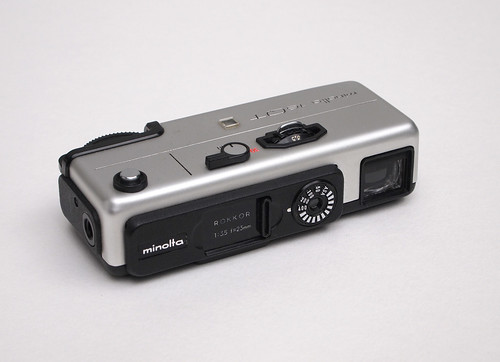 |
| Minolta 16 QT |
The
Minolta 16 QT was the last of Minolta's 16mm subminiature cameras, a series that began with the
Konan-16 Automat in 1947. Introduced in 1972, the QT coincided with the launch of Kodak's
110 format, which was the end for 16mm subminature cameras with proprietary cassettes (with a few exceptions). The following year, 1973, Minolta brought out the
Pocket Autopak 50 for 110, while production of the Minolta 16 QT was discontinued a year later. The camera features more plastic in its construction than previous Minolta subminiature models, making for a lighter camera, and the design isn't dissimilar to that of contemporary 110 format cameras. The QT is notable for being the only Minolta 16mm camera that had a focussing lens: previous cameras had fixed focus lenses, and while some had built-in 'portrait' filters, clip-on filters were also provided for distance focus - some cameras would not provide sufficient depth of field at wide apertures to focus on infinity. Incidentally, the Minolta 16 QT can use close up filters initially designed for copy stand work with the
Minolta-16 MG-S. The appeal of subminiature cameras is primarily their compact size: if the camera then needs accessories such as additional
filters to focus on near and far objects, part of that appeal is diminished.
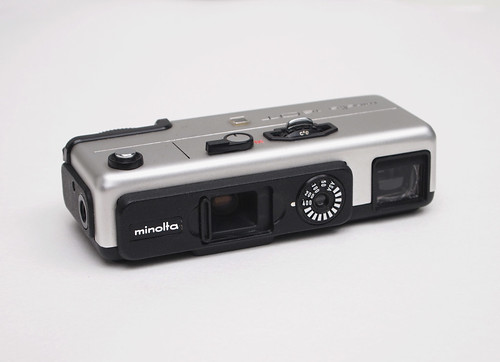 |
| Minolta 16 QT with lens cover open |
The lens is a Rokkor 23mm f3.5 with a sliding lens cover that also locks the shutter. Apertures are contiunously adjustable from f3.5 down to f22, this last aperture setting being smaller than most on subminiature cameras providing the QT with excellent depth of field - from 0.8m to infinity when set at the 2m or half-length figure mark. The aperture ring on top of the camera body accessed by pushing down the 'electric eye' button which activates the light meter. This shows 'O' when overexposed, 'K' for under, and both light at the correct exposure. The CDS light meter, with ASA settings from 50 to 400, is powered by a PX30 battery, accessed by opening the bottom plate for film loading. However, as battery only powers the meter, the shutter being mechanical, the camera itself will work without a battery and can be used manually. Operation of the camera is simplified by the use of just two shutter speeds: a switch on top of the camera selects either 1/250th or
(picked out in red) 1/30th.
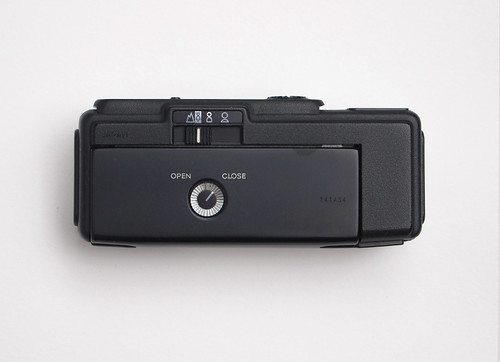 |
| Minolta 16 QT bottom plate |
The focus slider is located underneath the lens on the bottom plate with a series of pictograms: a mountain for infinity; full length figure (highlighted with a click stop for hyperfocal distance); half length figure; and head and shoulders. During the QT's production run this was changed to a distance scale in feet and metres (the settings are: 30ft/10m; 13ft/3.5m; 7ft/2m; 4ft/1.2m). The pictograms are also shown in the viewfinder with the selection highlighted. The viewfinder also has an outline for framing with crop marks for parallax and a red tab slides in at the top of the viewfinder to indicate when the shutter switch is set to 1/30th.
Minolta abandoned push-pull film advance after the Minolta 16 II. The QT's advance wheel is large enough to advance a frame without needing a large turn, being the subminiature equivalent of a single-stroke advance lever. The frame counter counts down 20 exposures after the 'S' mark for Start, to 'E' for empty, and although it is possible to shoot more than 20 frames, the counter remains at 'E' until the camera is opened, which resets the counter. The frame size was 12x17mm, just small enough to enable the use of single perforated 16mm film. The Minolta 16 QT also features a PC socket for flash with adjacent screw thread for its dedicated flash unit; and on the other side of the camera body is another screw thread for either hand strap or tripod. The camera case with belt loop has a rigid padded top to protect the electric eye button so as to prevent accidentally draining the battery.
 |
Top: Kiev submminiature cassette
Bottom: Minolta 16 cassette |
As described in my post about the
Kiev-30M, the Kiev cameras were initially based on the
Minolta 16 II, whereas Minolta continued to use the same cassette for all their cameras. Both cassettes have the same external dimensions, but the Kiev cassette was redesigned with a smaller take up spool to allow a greater length of film in the chamber. This means that Minolta cassettes will fit in Kiev subminature cameras, but not the other way around. With my recent interest in subminiature cameras, I picked up the QT at a low price in an online auction, but the camera did not come with a cassette. Searching for one to use the camera, the cheapest I found was a box
loaded with Kodak Plus-X with a 'develop before' date
of September 1971. Incidentally, this film is older than the camera itself: in the box alongside the
exposure instructions and process-paid envelope, there was also a sheet detailing the
three models of Minolta 16 cameras then available: the
Minolta 16 II, the
MG and the
PS (interestingly, the Minolta 16 II had a long producation run from 1957 to the early 1970s and
was offered alongside the models that Minolta subsequently developed).
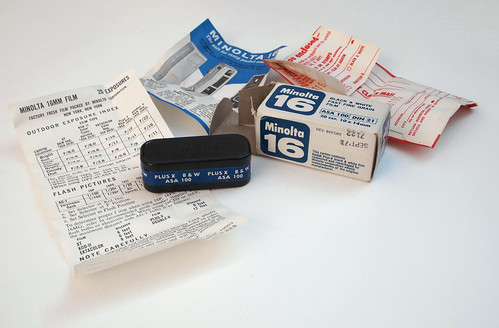 |
| Kodak 16mm Plus-X repackaged in Minolta 16 cassette |
As the film was well over forty years old, I assumed the Plus-X, originally 100 ISO, to have lost a fair amount of sensitivity. Without a battery, I used the 'sunny 16' to roughly calculate exposure, with bracketing. Most of the shots were at 1/30th using wider apertures; when I developed the film I realised that some of the frames were out of focus because the hyperfocal click stop at 3.5m (or full length figure) only gives a depth of field at f8 and above, and many frames were shot at f5.6. I used stand development with Ilfotec LC29 for one hour diluted 1:100. With plenty of exposure to compensate for age, the Plus-X film performed well. The images below are scans from the negatives; doubtless prints from the negatives would provide better quality.
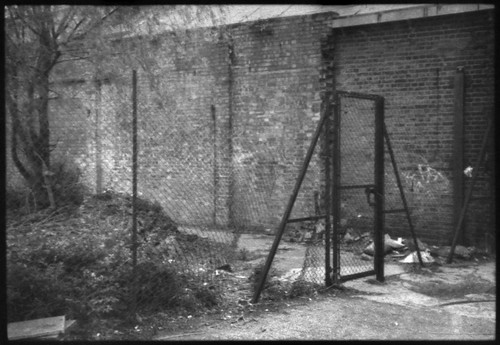 |
| Minolta 16 QT with expired Kodak Plus-X |
 |
| Minolta 16 QT with expired Kodak Plus-X |
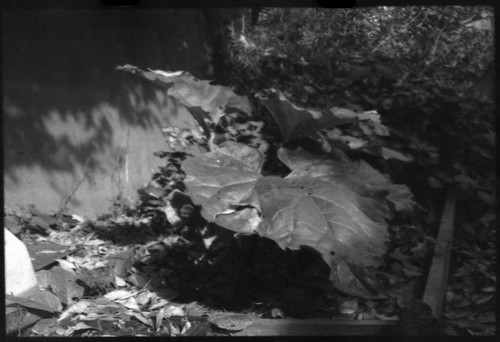 |
| Minolta 16 QT with expired Kodak Plus-X |
I subsequently reloaded the cassette with 16mm
Kodak WL Surveillance 2210 film, which is also single perforated. Processed in the same manner, the images below are also scanned from the negatives. The old Plus-X film appears to show finer grain than the WL Surveillance, but again a better test would be printing from the negatives in the darkroom.
 |
| Minolta 16 QT with Kodak WL Surveillance Film 2210 |
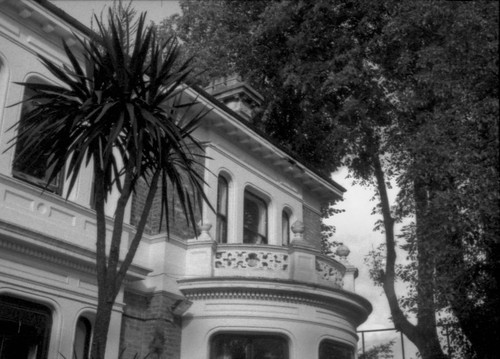 |
| Minolta 16 QT with Kodak WL Surveillance Film 2210 |
 |
| Minolta 16 QT with Kodak WL Surveillance Film 2210 |
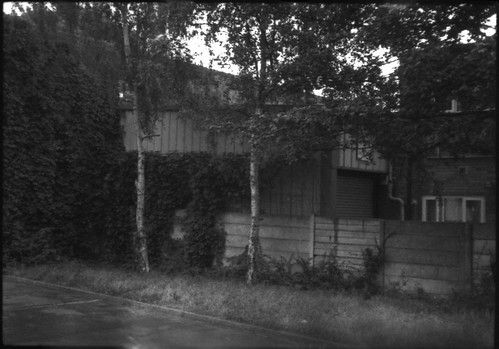 |
| Minolta 16 QT with Kodak WL Surveillance Film 2210 |
Sources/further reading:
Minolta Subminiature Variations on Submin.com
Minolta 16 QT on Camerawiki.com
Minolta Subminiature cameras at SubClub.org












No comments:
Post a Comment